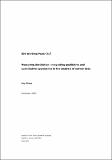Measuring destitution : integrating qualitative and quantitative approaches in the analysis of survey data
Abstract
Through detailed discussion of a methodology developed to quantify destitution in rural Ethiopia, the paper raises a number of issues and ideas concerning the integration of qualitative and quantitative approaches during survey analysis. It highlights the critical importance of using contextual data to inform quantitative analysis, for example in defining and scaling locally-appropriate indicators of such basic parameters as human capital and housing quality.
An index of physical labour capacity, adjusted for chronic illness and disability, is suggested as a more meaningful measure of household human capital in such a low-skill, low-opportunity livelihood system than the more commonly-used education or literacy variables. The potential application of this index to calculating “real” or effective household dependency ratios is also explored. The advantages and disadvantages of “qualitative” versus “objective” methods of weighting composite indices are compared.
Among the innovative aspects of the analysis is the triangulation of an “idea” destitution index constructed from discrete quantified variables with a subjective, holistic self-assessment of the household’s status. The very high correlation of results from the two approaches validates both the methods and the findings, and exemplifies the value of combined data types in representing the multi-dimensional reality of extreme poverty.
In operationalising the livelihoods approach, the focus is on quantifying access to (not merely ownership of) key assets, and outcomes. Again, the importance of contextual data and of locally-appropriate interpretations of the framework’s parameters emerges as of key importance. Although the discussion necessarily involves a degree of Ethiopia-specific information, the methods and issues raised are of much broader application to applied development research, and to the current “Q-squared” debate on combining methodologies.
Citation
Sharp, K. (2003) Measuring destitution : integrating qualitative and quantitative approaches in the analysis of survey data. Working paper series, 217. Brighton: IDS.Is part of series
IDS working papers;217Library catalogue entry
http://bldscat.ids.ac.uk/cgi-bin/koha/opac-detail.pl?biblionumber=145443Rights holder
Institute of Development StudiesCollections
- IDS Research [1671]

